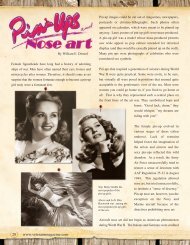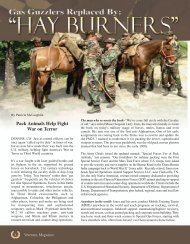Create successful ePaper yourself
Turn your PDF publications into a flip-book with our unique Google optimized e-Paper software.
Frank Hokr, 2Lt, Pilot<br />
B-24 J-5-DT Liberator<br />
England, December 17, 1944<br />
“TENMENAK” B-24<br />
Liberator Bomber. The<br />
name <strong>Tenmenak</strong> referrs to<br />
the shared prayer that all<br />
the men would survive<br />
every mission.<br />
On December 17, 1944, a<br />
major mission of over 550<br />
bombers was mounted by the<br />
15th Air Force, 461st Bomb Group, 764th bomb squadron.<br />
It was to attack a vital German target, the Odertal Oil<br />
Refinery in southern Poland.<br />
This is only one story of over fifty B-24 bombers, shot<br />
down that morning. Frank Hokr was one of the survivors<br />
who managed to escape the burning aircraft and parachute<br />
near a tiny Czech village called Lipal.<br />
Frank Hokr’s first air combat mission of World War II<br />
had taken a deadly turn. One moment the pilot of a B-24<br />
Liberator Bomber was winging toward an oil refinery in<br />
German-occupied Poland. The next moment, after being<br />
blown out, he was falling uncontrollably through space.<br />
A shell from the German anti-aircraft gun exploded,<br />
turning the B-24 Bomber into a fireball. Within seconds,<br />
life and death decisions were made. Frank Hokr bailed<br />
out of the bomb bay door of a burning B-24 Liberator at<br />
23,000 feet altitude. Hokr, pilot in command, received<br />
wounds from the shrapnel to his body and the ripcord<br />
cable on his chest pack parachute was cut in two. He<br />
pulled on the ripcord, but his chest pack didn’t open.<br />
Hokr removed his flight gloves and unsnapped the flaps<br />
covering the parachute opening, pulled out the flapping<br />
material until it spiraled upward and blossomed above<br />
him as he plunged through the Czechoslovakian sky.<br />
The rush of blood and air pounding in his ears came to a<br />
quick stop as the great OD color parachute canopy<br />
opened and silence prevailed. Unknown to Frank Hokr,<br />
his was heading toward a discomforting rendezvous with<br />
his parents' homeland and, almost certainly, the enemy.<br />
He drifted into the trees and was suspended by his<br />
parachute just above the ground. Within moments,<br />
German soldiers surrounded him. “Well, for you the war<br />
is over,” one soldier said in thickly accented English.
Most of his crewmembers were immediately captured by<br />
the German troops stationed in that area. Nine of the ten<br />
crewmembers parachuted to safely from the bomber. Frank<br />
Hokr and seven crewmates became prisoners of war. A<br />
ninth crewman avoided capture. The tenth flier, gunner Sgt<br />
Roland Morin, died in the barrage of antiaircraft flak. He<br />
went down with the plane in a Czechoslovakian field.<br />
Frank Hokr’s war continued in a prison camp in Germany.<br />
Hokr was treated humanely in Staling Luft 1. On the day<br />
of April 30, 1945, the German guards vanished and the<br />
Russian soldiers poured in, setting them free. Germany<br />
surrendered on May 7, 1945.<br />
After spending over half a year as a POW in a German<br />
prison camp, Frank Hokr eventually returned to the States.<br />
After World War II, Frank Hokr joined the Air Force<br />
Reserves. The Korean War called for the flying experience<br />
of Hokr and he returned to the battlefields of the Korean<br />
War. There he flew 67 missions. None of which left him<br />
with the emotional punch of parachuting out of a B-24 and<br />
being a prison of war in Germany.<br />
In the year 2000, Frank Hokr and four of the B-24 Liberator<br />
<strong>Tenmenak</strong> crew members traveled to Trencineska Treplice,<br />
Czechoslovak to visit the crash site.<br />
On a beautiful hill overlooking the town of Trencineska<br />
Treplice, Czechoslovak, the townspeople had built a<br />
memorial at the crash site nearly 10 years earlier. It was<br />
made from the remains of the B-24 “Tenmenbak” Bomber.<br />
The words on the memorial includes only one name from<br />
the crew: “In memory and honor of Corporal Roland W.<br />
Morin.” Morin’s body and dog tags were the only one<br />
found in the B-24 crash.<br />
The people in this town held a special ceremony and<br />
embraced the B-24 crewmembers. Frank Hokr is fluent in<br />
the local tongue and was the interpreter for his crew members.<br />
Hokr talked the mayor into playing traditional songs on an<br />
accordion. Hokr gathered iron and copper shards of the aircraft,<br />
holding onto the memories of a day that redefined him as<br />
one of a crew of ten.<br />
November 2005<br />
43
Let me now cite your own words from your letter, where, as<br />
you wrote, you were our debtor. 'You gave so much when<br />
you had so little, and now the least I can do is try to repay<br />
some of it. I know I can never repay you for what you did<br />
for me.'<br />
Well, let us examine these statements of yours a little. First<br />
of all, what did make you come to Europe and finally to<br />
our country? And why did you come over here? Was it only<br />
because you were commanded to go? And, did you need to<br />
go? America was not endangered. You could have stayed<br />
home and lived in peace in your great country. I say "great<br />
country," but the greatness of America was never in her<br />
territorial largeness or beautiful country. Her greatness<br />
was, and still is, in the unselfish spirit of her people. How<br />
otherwise, can you explain that once more the boys of that<br />
overseas country marched over here to fight; yes, but for<br />
whom did they come to fight?<br />
It remains a historical fact that it was America who helped<br />
and assisted our first President Liberator, Thomas Masaryk to<br />
establish our country, the Czechoslovak Republic. This was<br />
not only in that great Hall of Independence in Philadelphia,<br />
where Masaryk signed our Czech Declaration of<br />
Independence, but also the American boys who fought with<br />
arms to free us from the German/Austrian tyranny.<br />
How much more do we still owe you for the years<br />
of 1914-1918! And, now, thirty years later, again<br />
you American boys came over here - this time to<br />
defend and guard our liberty, the same liberty your<br />
boys helped us to put into existence more than thirty<br />
years ago. One of these friends was you, and you came<br />
to us in a Liberator, as one of our Liberators. This is<br />
significant for us, but also for you.<br />
But, did you ever think that the very moment you were<br />
mounting the Liberator, you virtually might have to give<br />
your life for those you were going to liberate?<br />
There is a verse in the Bible which says, "Greater love<br />
hath no man than this, that a man lay down his life for his<br />
friend" (John 15:13).<br />
My dear friend, when you were pressed to the floor of your<br />
bomber, unable to move, when you thought it was all over,<br />
then, in that moment you already laid down your life for<br />
friends you did not even know.<br />
Of course, you did not lose your life in that awful dramatic<br />
moment, but that was no merit of yours, but the grace of<br />
God who saved you, even out of the greatest danger."<br />
SOME FACTS ABOUT THE VIETNAM VETERANS MEMORIAL WALL<br />
The Main attration at the Vietnam <strong>Veterans</strong> Memorial is the Memorial Wall. The wall was designed by an undergraduate at Yale<br />
University, Maya Ying Lin, born in Athens, Ohio in 1959 who participated in a design contest and won. She acted as<br />
a consultant with the architectural firm of Cooper- Lecky Partnership on the construction of the Memorial. Ground<br />
breaking began in March of 1982, and it was finished in November of the same year. The Vietnam <strong>Veterans</strong> Memorial<br />
Fund, Inc. (VVMF) raised nearly $9,000,000 entirely through private contributions from corporations, foundations,<br />
unions, veterans and civic organizations and more than 275,000 individual Americans. No Federal funds were needed.<br />
Each of the walls is 246.75 feet long, composed of 70 separate inscribed granite panels, plus 4 at the end without names<br />
There are a total of 58,249 names inscribed on the granite.






